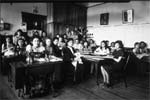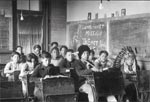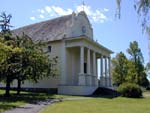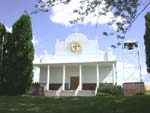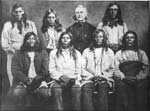 | | Father DeSmet and other headmen, ca. 1858 |
The coming of the "Black Robes" was foretold long before their arrival. In a great vision, Circling Raven, head chief during the 1600s, saw the coming of men wearing "long black robes with crossed-sticks under their belts" who would teach of a "new way to the heaven trails." In the spring of 1842 while on the prairie near Hayden Lake, the thirty-eight year old Father Pierre-Jean DeSmet was discovered wandering and lost by Stallam, the head chief at the time. For the Schitsu'umsh, it was less an opportunity "to learn from the priests [than] to teach the priests about the Coeur d'Alene ways and traditions!" The appeal of Christianity was eased by similarities in certain Catholic and Schitsu'umsh rituals and beliefs, as for example, in the belief in spiritual intermediaries such as saints and animal spirit guardians, the ritual use of sacred objects, water and incense, observance of feasting days, and the importance of religious practitioners, such as medicine people and priests. In addition, much of the desire to "welcome" the Black Robes was based upon their pledge to provide muskets, powder and shot to help hold off the ever menacing Blackfeet aggression. The weapons were never provided. "We accepted Catholicism, but on their own terms."
|
|
Sq'wt'u. Listen as Felix Aripa, Cliff SiJohn and Father Thomas Connolly discuss the Cataldo Mission, its origin and importance. Also take a look inside the mission. Built in the 1850's by the Schitsu'umsh, under the direction of Father Ravalli, the mission is the oldest standing building in the state of Idaho. (recorded and edited by John Hartman in August 2000 as part of the Coeur d'Alene Tribal GIS Names-Place Project)
|
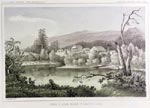 | | Cataldo Mission, lithograph by John Mix Stantely, ca. 1853. |
By the 1850s, under the direction of Father Antony Ravalli and with the labor of the Schitsu'umsh, the Mission of the Sacred Heart of Jesus, also known as the Cataldo Mission, was completed. Several families settled nearby and their children were soon being instructed in Catholicism and "civilized" skills. Beginning in the 1860's the Mission also served as an important rest area along the Mullan Road, linking Montana and Washington. But with the "bad influences" of miners and others so close at hand, the mission was moved in the 1870s to a "remote" site near of Hangman Creek, soon named, "DeSmet." The Sisters of Charity established and built a boarding school, with boys’ and girls’ dormitories, near the mission in 1878. More intensive instruction could now be directed at the youth of the tribe.
|
|
Listen as Felix Aripa discusses the impact of Lewis and Clark and the missionaries on the "old time religion" of the Schitsu'umsh (recorded and edited by Rodney Frey in August 2002)
|
It was the desire of Father DeSmet and those priests who followed him to establish a "wilderness kingdom for God." To accomplish this task, the priests first needed to stop the "wandering, nomadic" ways of the Schitsu'umsh and settle them into a sedentary, self-sufficient community, isolated from outsider influences, where they, the priests, could control the lives of the people. The Schitsu'umsh needed to become farmers. Under the supervision of the priests, the scale of plant cultivation rapidly increased, with oats, potatoes, and wheat among the crops grown using state-of-the-art farm equipment. Schitsu'umsh farming "success" was most renowned throughout the northwest during the 1890s and into the early 1900s. Families often employed white laborers, and typically owned two homes, one on their farms and the other used on weekends at DeSmet were Mass was celebrated. See Allotment.
|
|
Listen as Cliff SiJohn considers some of the influences of the Jesuit Missionaries, Indian Agents and "Conquering Civilization" on the Schitsu'umsh, resulting in a "sad blanket" laid onto the people and "turning the culture inside out." Part 3 of Interview; To begin the SiJohn Interview. (interviewed and edited by Rodney Frey, August 2002) |
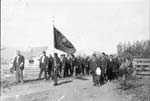 | | Soldiers of the Sacred Heart |
But if real success in converting the "heathen Indian" into a Christian was to occur, all vestiges of Schitsu'umsh religion and traditional ways had to be removed. Among the policies and practices used by the priests was to replace the use of traditional Indian names with "Christian names" such as Andrew and Debra. In the boarding school, one of the first acts was to cut the long hair of the children into an American hairstyle. The act was particularly traumatic as such hair cutting was done to mourn the death of a relative! Children were forbidden to speak their language and, within a few generations, the descriptive names of and connection with the Schitsu'umsh landscape began to be lost. With the assistance of the Soldiers of the Sacred Heart (devout Coeur d’Alene followers of the priests), the Jesuits made every effort to prevent traditional religious practices. Jump Dances and Sweat House ceremonies were banned. Medicine bundles and dance regalia were confiscated and publicly burned. For continual offenders and those deemed "evil," incarceration and "whipping" was instituted.
|
|
Cliff SiJohn continues discussing the impact of the Jesuits, from the burning of the medicine bundles to the activities of the Soldiers of the Sacred Heart, the "Church police."
Part 4 of Interview; To continue the SiJohn Interview. |
Despite initial successes many families resisted religious conversion. They secretly kept and used their medicine bundles. They attended and sang their suumesh songs (Spokane word for spiritual power) at Jump Dances held at remote locations, such as in the Lovell Valley (that was once much more forested). These were families that objected to the authoritarianism of the priests and to such alien theological concepts as "redemption" and "hell." Why would a "loving god" send his children to hell simply because they were not baptized? Many Schitsu'umsh felt betrayed when they discovered that the Jesuits established a mission among their most feared enemies, the Blackfeet. These were families that maintianed their spirital "Indian way."
By the 1930s and as exemplified in Father Cornelius Byrne, the harsh and restrictive policies of the Jesuits had been discontinued. Today Catholicism remains a vital part of the identity and religious practice of many Schitsu'umsh. The Black Robes are appreciated for helping bring a "new way to the heaven trails," as well as celebration at marriage and comfort at death. The Jesuit priests and Sisters of Charity have helped implement a Euro-American educational and health care system, challenged alcohol abuse, and have opposed outside economic and political interests that have sought to control the Schitsu'umsh. Over the last thirty years Father Thomas Connolly of the Sacred Heart Mission remains a "strong supporter of the Indian way," able to speak the language, eminently knowledgeable in the traditions and history of the Tribe, and a regular and well-respected participant at the powwows. Whether Catholic and "Indian Way"-oriented, the Schitsu'umsh families of today live side-by-side in the same community, worshiping in their own manner and respecting each other's practices.
© Coeur d'Alene Tribe 2002
< previous |
next > |



